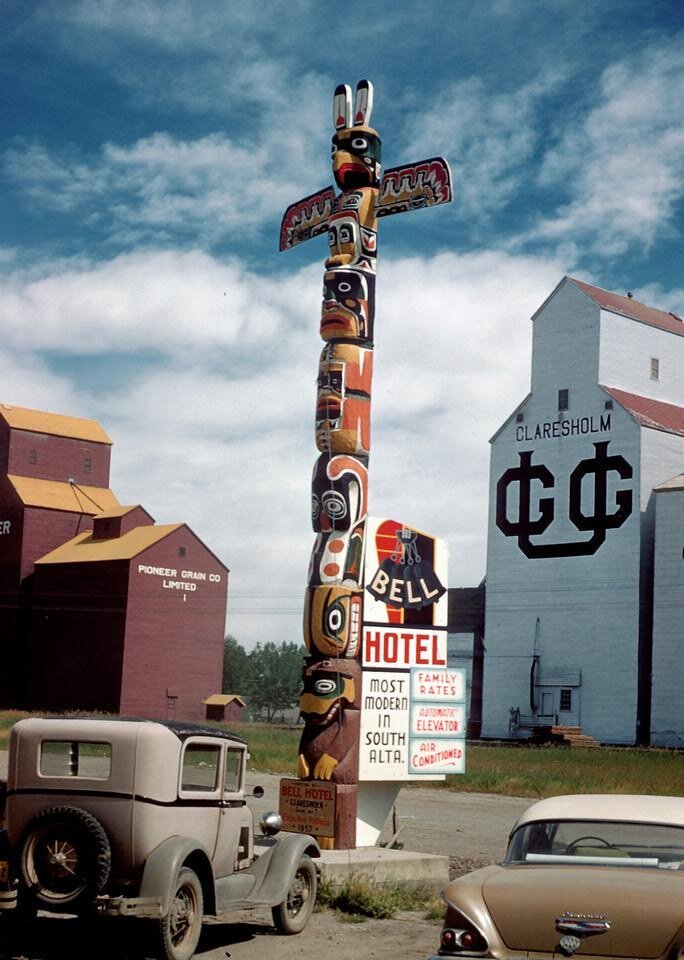
EXPLORE LIFE ON THE FARM
Teapot walls, tortoises and totem poles might have you wondering what we’re all about.
The teapots were an accidental over order, the tortoises were discovered on a vacation, and the totem poles have been a lifelong passion for our First Nations culture. To sum it up, we embrace life! Keep scrolling to see more.
O U R T O T E M P O L E S
-

CAPILANO NATIVE BAND
Carved in 1950 by Chief Joe Mathieu of the west coast, this totem pole was commissioned by Dr. Bell, owner of the Bell Hotel in Claresholm, Alberta. It stood as an iconic attraction in front of the hotel for 65 years until it became unstable and was taken down, nearly forgotten. In 2013, Paul Hamer discovered its absence, tracked it down, and acquired it. After extensive restoration at the Saskatoon Farm, it was re-erected, where it proudly stands today.
At the top is the Thunderbird, symbolizing power and strength. Below it is the Bear Mother, a common west coast legend, followed by the killer whale with a human riding it, representing harmony and protection, particularly for travelers. Finally, the Bear symbolizes courage, family, and strength.
Totem poles often arrange symbols so that those higher on the pole hold greater significance, leading to the phrase “low man on the totem pole,” meaning someone at the bottom of the hierarchy.
-

THE MOTHER POLE
Carved in 1968 by an unknown artist, this totem pole was found on the west coast and brought to the Saskatoon Farm for restoration in 2016. It is believed to be of Tlingit Native Band origin.
The figures and symbols on the pole may represent or commemorate ancestors, cultural beliefs, legends, clan lineages, or notable events. At the top is the Thunderbird, a mythical creature believed to control natural forces and provide protection. Below it is the Bear mother, a common legend about a young princess who, after being helped by bears, marries a chief's son and gives birth to twin half-man, half-bear sons, symbolizing the unity between man and bear. At the bottom is a unique figure of a pregnant woman, a rare symbol in totem art.
A totem pole is a tall structure created by Northwest Coast Indigenous peoples to showcase a nation’s, family’s, or individual’s history, and display their rights to territories, songs, dances, and culture. The word "totem" comes from the Algonquian word odoodem, meaning "his kinship group" (family or clan).
-

HAIDI POLE
Carved in 1960 by William Jeffrey, a prominent Haida carver from Port Simpson, this totem pole was purchased by a family in Somerside, PEI, and erected in their tourist facility. After the business closed in 2001, the pole was acquired by the Canadian Pickers TV show and sold to Paul Hamer at Saskatoon Farm, where it was restored and featured on the show.
The figures and symbols on the pole represent ancestors, cultural beliefs, legends, clan lineages, and notable events. At the top are the Three Watchmen, who call out when danger approaches, followed by a Thunderbird. Between its wings is a killer whale carrying a human, symbolizing family, romance, longevity, harmony, travel, community, and protection. At the bottom is the Bear mother figure, a common legend depicted on poles.
-

THUNDERBIRD POLE
Carved in the 1960s by an unknown artist, likely from the Tlingit Tribe, this totem pole was originally found in northern British Columbia and brought to the farm in 2017 for restoration.
The thunderbird, initially in poor condition with broken wings, was restored and erected in 2019. Its design features traditional carvings, including the thunderbird clutching a salmon, symbolizing abundance and prosperity. Below, an orca carries a man, representing security and unity, while at the bottom, a bear symbolizes independence, strength, and self-reliance.























